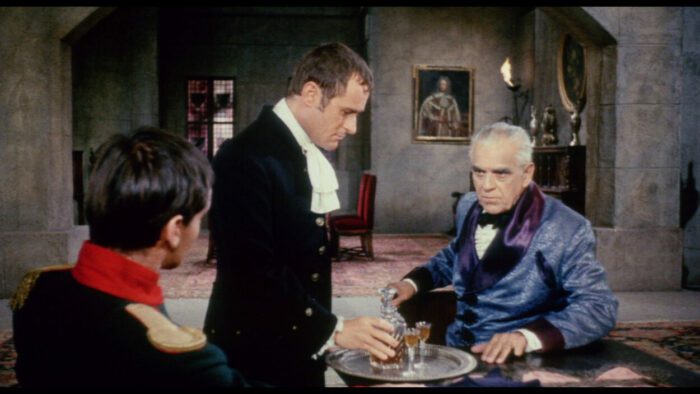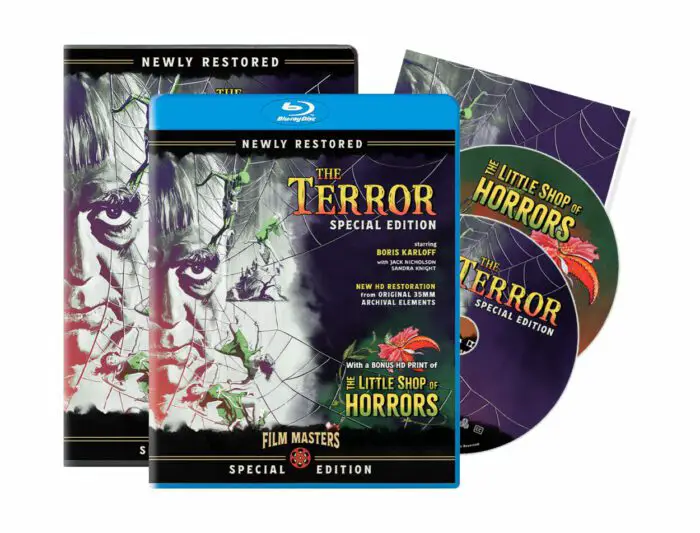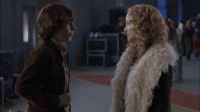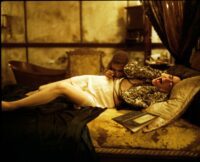Film Masters, the consortium that began producing physical media earlier this year, continues attention to the restoration and preservation of the work of low-budget auteur Roger Corman with its newest release. Top-billed is the 60th-anniversary edition of The Terror (1963), his gothic horror pitting Jack Nicholson against a formidable adversary in Boris Karloff, packaged together here with his 1960 The Little Shop of Horrors, the whimsical horror comedy that became the inspiration for a hit musical and later film adaptation. Both Corman films are restored in a double-feature, special-edition, two-disc, collector’s set on Blu-ray and DVD releasing later this month. And as they have with each prior release, Film Masters has worked to set these public domain works in new and richly drawn contexts with contributions from a number of Corman devotees and aficionados.
The Terror (1963)
Even if you think you’ve never seen The Terror before, you probably have, or at least a part of it, if you’ve ever channel-surfed late-night television, and there is no shortage of public domain versions of various quality floating about the internet and nearly every streaming service. The Terror has also popped up on dozens of low-rent physical media releases—and just seven years ago a perfectly credible Blu-ray restoration. The Terror is one of those films that in all honesty is probably a lot more interesting for its notoriously complex and compromised production history—and its long cinematic afterlife—than on its own artistic merits. It’s not by any means a great film, but it is great fun, full of pop-Freudian symbolism and a wild ending.
A young Jack Nicholson, one of the film’s four uncredited directors who worked on different portions of the film alongside Corman, plays Andre Duvalier, an early 19th-century French Lieutenant in Napoleon’s army. Alone and separated from his regiment, he encounters a young woman (Nicholson’s then-wife, Sandra Knight) who enraptures him before disappearing. His curiosity piqued, Duvalier then happens upon the castle of Baron Von Leppe (Boris Karloff); there he notices a painting of the Baron’s late wife Ilsa, who looks identical to the mysterious woman he met on the beach, even though Ilsa died decades ago. And so Duvalier becomes determined to uncover the identity of the mystery woman. But doing so puts him and everyone around him in greater jeopardy than he could have imagined when all of the castle’s secrets are revealed in a wet and wild ending.

The Terror looks and feels very much like one of Corman’s Poe-cycle features and with good reason: it borrowed sets, cast, crew, and themes from them without any direct reference to Poe. Its gothic setting and dark secrets make it feel like it could have been adapted from story the author might have found even a bit too tawdry for his own sensibilities. It was something of a cobbled patchwork. Karloff owed Corman two days of work from a prior project, and eventually the film took five directors (including not only Nicholson but also Francis Ford Coppola and Monte Hellman) and nine months, unusually long for a Corman effort, to complete.
And somehow, the end result is, for all its messiness, a psychological horror delight. Nicholson’s motives are sexual in nature; vaginal and phallic symbols abound; and Karloff is, as always, an imposing villain. Corman took the two days owed him by Karloff and made the most of them, nearly drowning him, Knight, and Dick Miller in a feverishly flooding final sequence. The film’s special effects are typical low-budget high-effect Corman fare, and the plot, for all its twisty turns and sick revelations, doesn’t really make any logical kind of sense, but The Terror, like so much of Corman’s output, simply has its own ineffable, engaging magic. And this presentation from Film Masters is a far better one than any you’ll find in the public domain.
The Little Shop of Horrors (1960)
Unlike The Terror—and far more like most of his rapid-fire productions—The Little Shop of Horrors is in many ways a typical Roger Corman production. Shot on a shoestring with non-union crew and a cast of his core stock actors, Little Shop got made in a heartbeat, practically inventing its zany script and knocking out principal photography in just a couple of days. Corman was up against a deadline, a new Hollywood production rule that would require paying actors residuals for their work, and he set out to beat the clock with one last film, shot in the last week of December 1959, that would fall under the old rules—and per usual for Corman, save some money.
With temporary access to sets left standing from his previous film, A Bucket of Blood, Corman made the decision to use the same sets before they were torn town—in two days. Charles B. Griffith came up with the compromised script for another horror film, but this time, with a comic bent. The plot is as zany as can be: nebbish Seymour (Jonathan Haze), a lonely florist, pines for co-worker Audrey. When he accidentally feeds a plant a drop of his own blood, it thrives, and he gives the now-hungry plant the name Audrey Jr. in her honor. But Audrey Jr. becomes insatiable, demanding more and more human flesh for food, and through no ill intent of his own, poor Seymour becomes a less-than-willing accomplice to his creation.

Shot in a live-television style with three cameras in wide and medium shots, the film didn’t look like anything special. But when audiences laughed riotously at screenings, the filmmakers knew they had made something not only unique, but funny. Its humor gave the film legs and helped make it a late-night favorite on college campuses. Years later, when Jack Nicholson reached fame, his fans sought it out (he gives a manic performance in a small role, just his third appearance on film). Then, decades later, it earned a new life as a beloved Broadway musical in 1982, adapted back onto film in 1986. Those adaptations only whetted the appetite for seekers of the original tale, and here on Film Masters’ new remaster, the film looks as clear and sharp as is imaginable. Like The Terror, Little Shop isn’t great cinema; but also like The Terror, it’s great fun for fans of cinema.

Special Features
Audio Commentary on The Terror. Authors C. Courtney Joyner, a regular Film Masters contributor, and Steve Haberman exchange ideas in a wide-ranging and thoughtful commentary track addressing nearly every aspect of The Terror, from its illustrated title sequence to its complicated production history to its Freudian meanings and symbol structures. Joyner and Haberman’s dialogue feels natural and uncontrived, with plenty of give-and-take, but it nonetheless efficiently and thoughtfully stays on topic, examining the contributions of each of the film’s “uncredited” co-directors to the final product.
Audio Commentary on The Little Shop of Horrors. Author Justin Humphreys provides a full commentary track for the film alongside the actor Jonathan Haze, who played the film’s protagonist Seymour Krelborn. At 94, Haze is a treasure, and it’s a delight to hear him reminisce about his working relationships with Roger Corman and co-star Dick Miller. Having actors try to recall details of their work on set from decades ago (in this case more than seven of them!) doesn’t always work, but Humphreys is a perfect host for Haze, making his own assessments and observations about the film while guiding Haze through plenty of opportunities to comment on this and the other films on which he collaborated with Corman.
Hollywood Intruders: The Filmgroup Story. Film Masters had presented Part One of this documentary, with no indication of when or where Part Two might appear, on their earlier release of The Beast from Haunted Cave. Here, two months later, is Part Two, which begins in media res and halts with no conclusion or indication of when or where any subsequent sections will appear. The featurette, by Howard S. Berger for Ballyhoo Motion Pictures, addresses, roughly, the period between the two films featured in this set. While I can understand the decision to pair up individual sections of the larger whole with the release of the specific films to which they allude, the documentary itself suffers from being chopped up and released in these 17-minute sections, and as strong as the content is, it’s nearly impossible to trace the chronology of Corman’s output or Filmgroup’s development from this presentation. Joyner hosts again, affably and knowledgeably, with clips from Last Woman on Earth and Creature from the Haunted Sea set alongside Corman’s Poe films, The Terror, and Little Shop of Horrors.
Ghosts in the Machine: Art & Artifice in Roger Corman’s Celluloid Castle. This 44-minute visual essay from Berger and Kevin Marr outlines Corman’s career in general with a focus on this middle period and his response to tighter budget with more outrageous humor. From the Poe cycle to The Terror, focusing on its well-known and oft-told production history with some additionally keen insights on the film’s thematic meanings. Though at times these can lapse into a simple narration of selected scenes, comparisons between The Terror and other films (e.g. Alfred Hitchcock’s Vertigo, Stanley Kubrick’s The Shining) exploring the themes of duality and obsession, with special attention to the use of set dressings, wardrobe, and plot to bring The Terror to its shock conclusion.
Also included are recut trailers for both films, based on the original theatrical trailers. The jewel case includes a color booklet with essays by Joyner, “Boris Karloff and the Long Shadow of Poe,” on the decades-long connections between The Terror star and the works of Edgar Allan Poe onscreen and another by Mark McGee, “Faster! Faster!,” on the whirlwind production and long impact of The Little Shop of Horrors. Both are well worth a read, complementing the other supporting materials without repeating them.
Curiously, there are no notes about the restoration of The Terror, which is advertised on the case as a “New HD Restoration.” The film had earlier been restored for a prior Blu-ray release in 2016 by The Film Detective. As attractive a package as Film Masters has produced here, there seems to be little obvious difference between versions, and at the very least, some information about whatever new restoration has been conducted would be of interest to provide.
The Little Shop of Horrors looks absolutely pristine in its presentation; The Terror, less so, though in some sections its restoration is excellent and in others it is a muddled, out-of-focus, mess; it is certainly better, though, than any of the dozens of versions floating about the internets, including the one hosted by Elvira—at least until she fell asleep. Its complex production history and multiple directors probably accounts for the wildly uneven quality of its visual presentation. Both films are presented with an aspect ratio of 1.85:1. The discs are region free and include English SDH, with DTS-HD/Dolby AC3s audio.
Film Masters continues to impress with this package. Like Corman, they aim to do a lot with a little. Film Masters lacks the connections and cachet of bigger and better-known companies like Criterion, but they have developed a stable of knowledgeable contributors and found work in the public domain that deserves attention and restoration. With now a half-dozen releases to their name, they’ve provided consistently strong visual presentations and thoughtful audio commentaries, often with surprise guests (like Haze here or Cora Sue Collins, also a nonagenarian, who played little Pearl in the 1934 version of The Scarlet Letter and joins on a commentary track on that release). Not all of the editorial decisions make sense, and it’s fair to want for more forthcoming information about the restorations advertised, but kudos to all involved for making the effort to preserve and contextualize some of cinema’s less prestigious, but no less interesting, fare.
The two-disc set (MSRP Blu-ray $29.52 / DVD $19.95) is available from retailers Dec. 12, 2023 and is available from Amazon for pre-order.



